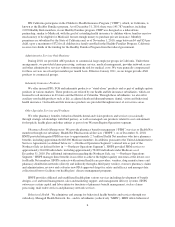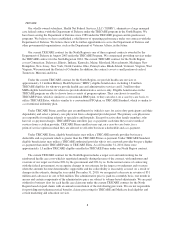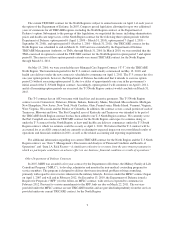Health Net 2010 Annual Report Download - page 18
Download and view the complete annual report
Please find page 18 of the 2010 Health Net annual report below. You can navigate through the pages in the report by either clicking on the pages listed below, or by using the keyword search tool below to find specific information within the annual report.deductible, additional regulations governing premium rate increase requests, requirements that individuals obtain
coverage and the creation of government controlled “exchanges” where individuals and small business groups
may purchase health coverage.
Some provisions of the health care reform legislation became effective in 2010, including those that increase
the restrictions on rescinding coverage, those that bar health insurance companies from placing lifetime limits on
“essential benefits,” which are only partially defined, those that prohibit annual limits below specified caps for
essential benefits for some benefit plans and those that require health plans to cover certain out-of-network
services with no additional co-pay to their enrollees. Some provisions that significantly increase federal
regulation of the handling of appeals and grievances were to become effective in 2010, but enforcement was
postponed until July 1, 2011. Some of the potentially more significant changes, including the annual fees on
health insurance companies, the excise tax on high premium insurance policies, the guaranteed issue
requirements, the requirement that individuals obtain coverage, and the creation of exchanges, as described
above, do not become effective until 2014 or later. Implementation of other provisions generally varies from as
early as enactment or six months from the date of enactment to as late as 2018. In advance of the September 2010
federal implementation date, we voluntarily provided the option of continuing coverage for adult dependents up
to age 26 who are currently enrolled on their parents’ health care policies. In addition, we reaffirmed our existing
policy against rescinding members without approval from an external third-party reviewer, which has been in
effect since 2007.
Various aspects of the health care reform legislation could have an adverse impact on our revenues and the
cost of operating our business. For example, the new legislation will lower the rates of Medicare payments we
receive, may make it more difficult for us to attract and retain members, increase the amount of certain taxes and
fees we pay, impose a sales tax on medical device manufacturers and increase the amount of fees pharmaceutical
manufacturers pay (both of which in turn could increase our medical costs), require rebates related to minimum
medical loss ratios and require premium rate review. We could also face additional competition as competitors
seize on opportunities to expand their business as a result of the new legislation, though there remains
considerable uncertainty about the impact of these changes on the health insurance market as a whole and what
actions our competitors could take. Because of the magnitude, scope and complexity of the new legislation, we
also will need to dedicate substantial resources and incur material expenses to implement the new legislation,
including implementing the current and future regulations that will provide guidance and clarification on
important parts of the legislation.
Any delay or failure by us to execute our operational and strategic initiatives with respect to health care
reform or otherwise appropriately react to the new legislation and implementing regulations could result in
operational disruptions, disputes with our providers or members, regulatory issues, damage to our existing or
potential member relationships or other adverse consequences. Moreover, there are numerous steps required to
implement this new legislation, with clarifying regulations and other guidance expected over several years
including, for example, guidance with respect to the methodology of calculating minimum medical loss ratios. In
October 2010, the NAIC finalized its recommended methodology for calculating the minimum medical loss ratio
as required by the ACA. Among other things, the NAIC’s model language provided for capitation expenses to be
included, in full, as medical expenses for purposes of the calculation. In December 2010, the U.S. Department of
Health and Human Services (“HHS”) issued interim final rules regarding medical loss ratios, effective as of
January 1, 2011, which specified in the preamble that HHS was adopting the NAIC model language.
Nonetheless, certain language included in the interim final rules raises a question as to whether or not the
NAIC’s methodology was adopted in whole or in part. In the event that the final regulations ultimately issued by
HHS are determined to alter the NAIC model for calculating minimum medical loss ratios, it could have an
adverse impact on our business and results of operation.
New guidance on certain other provisions of the federal reform legislation has been issued (for example,
guidance relating to guaranteed issuance of coverage to children under age 19, coverage for preventive health
services without cost-sharing, lifetime and annual limits, rescissions and patient protections), but we are still
16
























